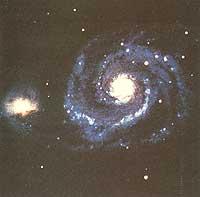About the creation of elliptical galaxies
As we saw in analyzing the Hubble classification, galaxies are usually divided into three groups, but the most important and numerous are two: spirals and elliptics. It was already commented that today most astronomers do not believe that there is an evolutionary relationship between these groups. For this majority, galaxies formed in a relatively early phase of the evolution of the Universe, the first hundred million years after the big bang.
According to this hypothesis, elliptical galaxies would be produced by the slight compression of the protogalaxy and in the free-fall process the stars would evolve before the clouds (protogalaxies) in their entirety. Therefore, the stars show a random distribution of speeds. On the contrary, spiral galaxies would be created after protogalaxies evolved more slowly and acquired disk form.
However, astronomers do not correspond to this mainstream. For them the appearance of galaxies was not so early. What's more, Elhuyar. Based on the computer models of collision analysis of galaxies exposed in the previous issue of Science and Technology, they argue that elliptical galaxies have originated from spiral collisions. No doubt, all astronomers recognize that some elliptical galaxies are a consequence of shocks, such as those dominant in the cluster we referred to in the previous number; but, according to the second group mentioned, most elliptical galaxies are thus formed.

F. Schwizer is one of the defenders of this latest hypothesis. He has studied in depth the galaxy NGC 7252 and has found some properties: on the one hand, those that suggest that this galaxy is a consequence of the collision of two others and, on the other, those that have recently been discovered in elliptical galaxies. One of the clearest evidence is the two movements that appear in the body of NGC 7252. Measurements of the speed of the ionized gas of the galaxy show that the nucleus of the galaxy rotates at 50 km/s, but the surrounding layer rotates in the opposite direction and at double speed.
Four groups of astronomers have discovered the same phenomenon in different elliptical galaxies. In recent times, computer simulations have also offered similar results for the distribution of speeds. In these works, the models conform to reality in terms of the appearance of the incipient galaxy, since like the NGC 7252 they present two tails in opposite directions. Of course, these tails indicate that the galaxy is a shock. The value of the speed of stretching of the tails can be deduced the duration of the process, which are around one billion years.
The second particularity is that corresponding to the distribution of the luminosity of the galaxy. This distribution is much more like that of an elliptical galaxy than that of the spiral. It seems, therefore, that the shock process is about to end and that both spiral galaxies have completely mixed together and have created a stable elliptical system.
There are more reasons that point out that elliptical galaxies have not been born in the early times of the Universe. W. Baum analyzes the luminosity distribution of three Coma Kumulu elliptical galaxies by observing the magnesium absorption line. Magnesium is a heavy metal that is due to the explosion of previous stars. Therefore, it is representative of the age of the stars of a region. Normally an elliptical galaxy presents in its nucleus the abundance of magnesium, since it is where most stars are formed. Outward concentration decreases.
W. Baume, however, has found a uniform distribution in the three galaxies mentioned, extending the magnesium richness to the last limits. J. Gallagher's interpretation of this observation is that the stars outside these elliptical galaxies are not of local origin. Most of the gas must be produced in a place that has become a star, where the process has been repeated several times.
Not all are, however, favorable reasons. There are problems. One of the most discussed is the density of the elliptical galaxy nucleus. This density is hundreds or thousands of times greater than the spiral galaxy. Efforts have been made to explain this increase, but the problem is not yet clear.
One more note to finish. F. According to Schwizer, 75% of shocks that have created elliptical galaxies have occurred in the first half of the universe age and the other 25% later.
EPHEMERISSUN : 22 November at 19 h 35 min enters Sagittarius.
PLANETS
|





